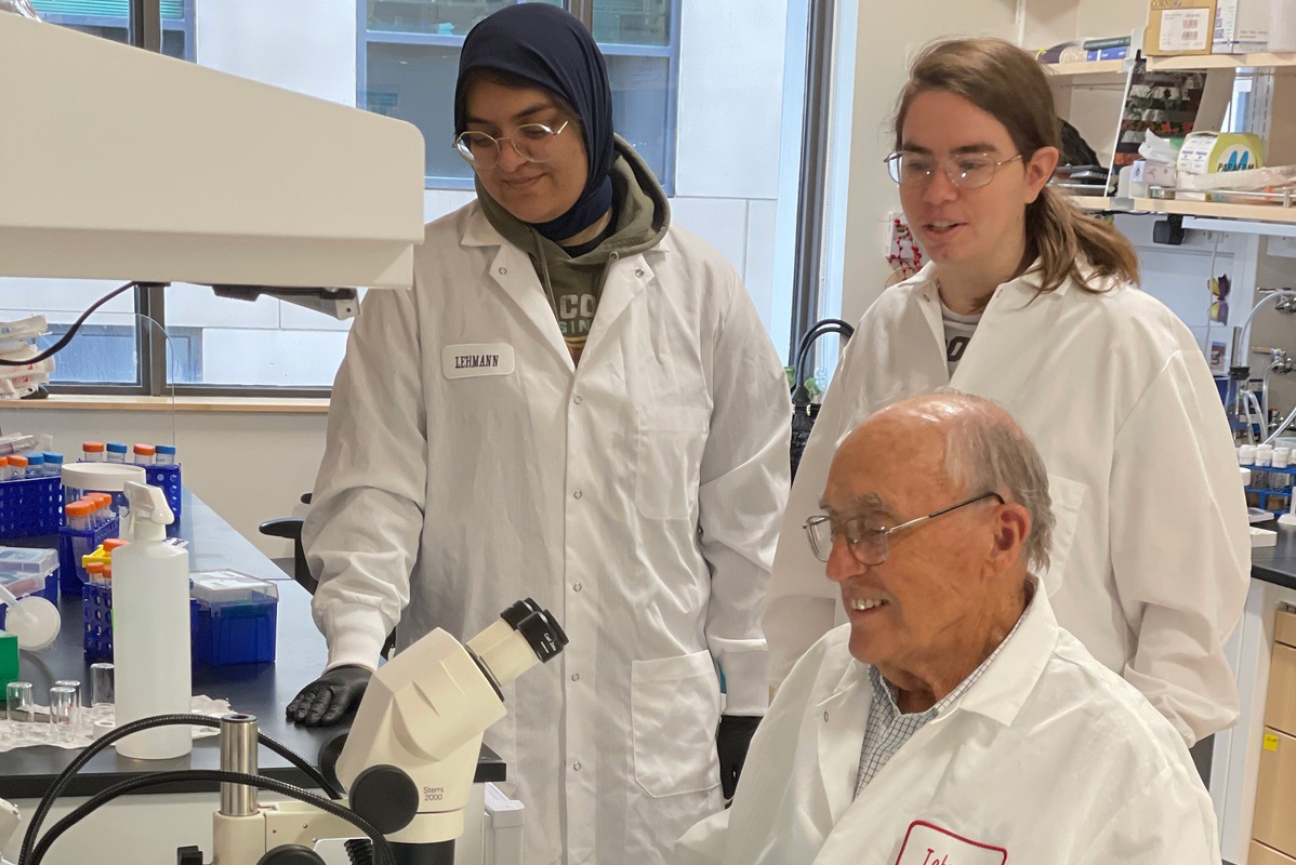
Anthony (Tony) Mahowald (bottom right) with Lehmann lab members.
A scientific career spanning generations
It’s often said that postdocs and students are the central engine driving basic science labs. And early career researchers do comprise the largest portion of the research staff at Whitehead Institute. But there is a broad range of ages represented in our primary investigators’ labs: from 20-year old Massachusetts Institute of Technology students to scientists in their 80’s and 90’s.
Perhaps the most senior member of the Institute’s research staff is 90 year-old Anthony (Tony) Mahowald: former university professor and department chair, and—during a scientific career spanning nearly 70 years—a bench researcher who has explored the structure of pole cells, polar granules, and oogenesis in Drosophila.
In 2002, Mahowald closed his own research laboratory and retired from the academic career that he started in 1962 as a faculty member at Marquette and Indiana Universities and continued at Case Western Reserve University, where he chaired two academic departments. In 1990, he moved to the University of Chicago, where for 12 years he served as Louis Block Professor and chair of the department of molecular genetics and cellular biology. Among many recognitions of his accomplishments during five decades of university-based research, Mahowald was elected to the National Academy of Sciences and the American Academy of Arts and Sciences.
But his passion for science remained undiminished. After retiring from the University of Chicago, Mahowald planned to volunteer to work at the bench in any lab that would take him. He first went to Margaret Fuller’s lab at Stanford University, where he switched research fields and studied spermatogenesis. Besides the challenge of working on a different biological organ, he enjoyed collaborating with Fuller lab postdoc—and now Whitehead Institute Member—Yukiko Yamashita. After one year at Stanford, family needs prompted him to return to Chicago and he joined the lab of Edwin Ferguson and Sally Horne-Badovinac. There, he resumed his study of oogenesis in Drosophila, collaborating with graduate students and postdocs and contributing EM data to their research.
In 2013, the call of family led Mahowald and his wife—herself a retired professor of medical ethics at the University of Chicago—to move to Massachusetts, where his initial year was filled with helping his grandchildren and reading historical biographies. Soon, however, the siren-call of science led Mahowald to return to the laboratory. He began working in the lab of then-Institute Member Terry Orr-Weaver, which focused on oogenesis and early embryonic development, problems closely related to Mahowald’s former research program. While assisting students in the lab with studies utilizing the electron microscope, Mahowald discovered a previously unidentified subcellular structure in the initial cells derived from the ovarian germline stem cell. He presented a poster on his work at the annual meeting of the American Society for Cell Biology—after which, a friend at Harvard Medical School alerted him to its similarity to receptor bound double-stranded RNA that a colleague had analyzed by X-ray crystallography.
After Orr-Weaver retired in 2019, Mahowald moved to then-Institute director David Page’s lab where he continued ultrastructural studies of the novel organelle. Unfortunately, the Covid-19 pandemic kept Mahowald away from the Institute for two and a half years. But in June, 2022 Institute director Ruth Lehmann invited him to become a part-time member of her lab. Mahowald had first met Lehmann in the 1980’s when she was a graduate student at German’s Tubingen University and they were both attending a workshop in Heidelberg. Today, serendipitously, Lehmann shares lab facilities with Yukiko Yamashita, with whom Mahowald had collaborated years before at Stanford.
Mahowald’s time working with the Lehmann and Yamashita labs has given him a chance to continue studying the unusual structure he identified several years earlier in the Orr-Weaver lab: exploring how it forms, what determines its formation, and what its function is. He hypothesizes that the structure develops in flies growing in population cages are open to the environment—rather than the standard mode of growing flies in vials and bottles with cotton-plugs, which essentially isolates them from the environment.
Mahowald’s continuing engagement is but one example of the multifaceted nature of scientific research, generally—and, especially, of the collaborative and diverse culture that is a key element of Whitehead Institute’s ongoing success.
Topics
Contact
Communications and Public Affairs
Phone: 617-452-4630
Email: newsroom@wi.mit.edu


